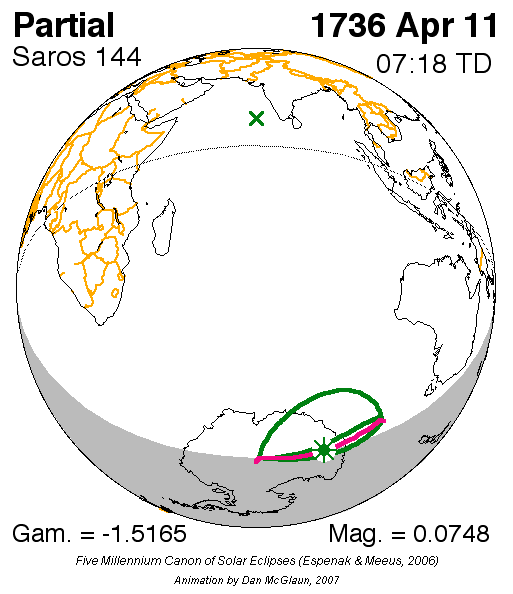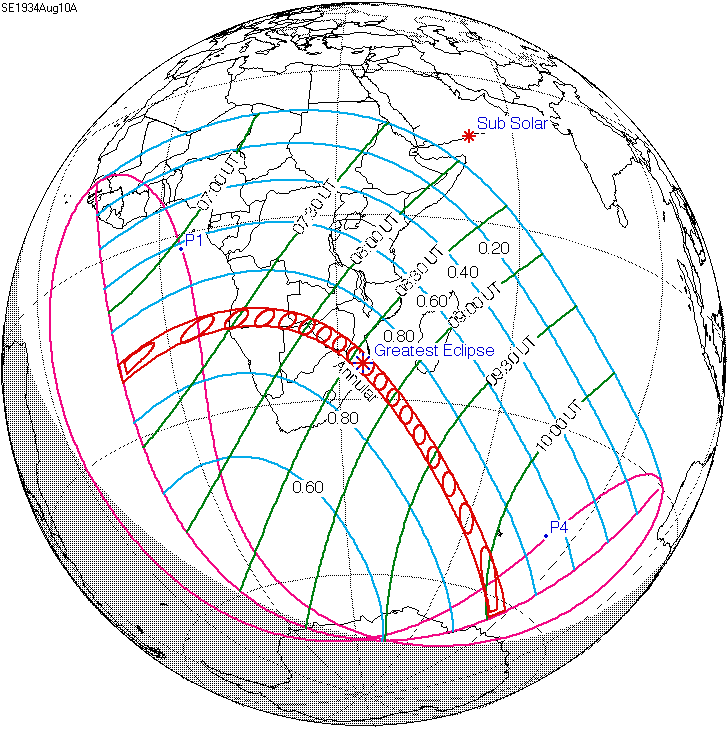|
Solar Eclipse Of September 22, 2006
An annular solar eclipse occurred at the Moon's descending node of the orbit on September 22, 2006. A solar eclipse occurs when the Moon passes between Earth and the Sun, thereby totally or partly obscuring the image of the Sun for a viewer on Earth. An annular solar eclipse occurs when the Moon's apparent diameter is smaller than the Sun's, blocking most of the Sun's light and causing the Sun to look like an annulus (ring). An annular eclipse appears as a partial eclipse over a region of the Earth thousands of kilometres wide. The path of annularity of this eclipse passed through Guyana, Suriname, French Guiana, the northern tip of Roraima and Amapá of Brazil, and the southern Atlantic. Images Animated path Related eclipses Eclipses of 2006 * A penumbral lunar eclipse on March 14. * A total solar eclipse on March 29. * A partial lunar eclipse on September 7. * An annular solar eclipse on September 22. Tzolkinex * Preceded: Solar eclipse of August 11, 1999 * ... [...More Info...] [...Related Items...] OR: [Wikipedia] [Google] [Baidu] |
Annular Solar Eclipse
A solar eclipse occurs when the Moon passes between Earth and the Sun, thereby obscuring the view of the Sun from a small part of the Earth, totally or partially. Such an alignment occurs during an eclipse season, approximately every six months, during the new moon phase, when the Moon's orbital plane is closest to the plane of the Earth's orbit. In a total eclipse, the disk of the Sun is fully obscured by the Moon. In partial and annular eclipses, only part of the Sun is obscured. Unlike a lunar eclipse, which may be viewed from anywhere on the night side of Earth, a solar eclipse can only be viewed from a relatively small area of the world. As such, although total solar eclipses occur somewhere on Earth every 18 months on average, they recur at any given place only once every 360 to 410 years. If the Moon were in a perfectly circular orbit and in the same orbital plane as Earth, there would be total solar eclipses once a month, at every new moon. Instead, because the Moon's ... [...More Info...] [...Related Items...] OR: [Wikipedia] [Google] [Baidu] |
Solar Eclipse Of August 11, 1999
Solar may refer to: Astronomy * Of or relating to the Sun ** Solar telescope, a special purpose telescope used to observe the Sun ** A device that utilizes solar energy (e.g. "solar panels") ** Solar calendar, a calendar whose dates indicate the position of the Earth on its revolution around the Sun * Solar Maximum Mission, a satellite * SOLAR (ISS), an observatory on International Space Station Music * "Solar" (composition), attributed to Miles Davis * ''Solar'' (Red Garland album), 1962 * ''Solar'' (Taeyang album), 2010 * ''Solar'', a 2011 album by Rubik * "Solar", a song by Northlane from '' Mesmer'', 2017 * SOLAR Records, a record label Geography * Solar (Spanish term), a type of urban site * Solar, County Antrim, Northern Ireland, United Kingdom * Solar, Erode, India * Solar, Iran, Iran Companies * Solar Entertainment Corporation, a Philippines television and radio media company * Solar TV, a former TV channel * Solar Television Network, Inc., a former na ... [...More Info...] [...Related Items...] OR: [Wikipedia] [Google] [Baidu] |
Solar Eclipse Of August 10, 1934
An annular solar eclipse occurred on August 10, 1934, with an eclipse magnitude of 0.9436. A solar eclipse occurs when the Moon passes between Earth and the Sun, thereby totally or partly obscuring the image of the Sun for a viewer on Earth. An annular solar eclipse occurs when the Moon's apparent diameter The angular diameter, angular size, apparent diameter, or apparent size is an angular distance describing how large a sphere or circle appears from a given point of view. In the vision sciences, it is called the visual angle, and in optics, it is ... is smaller than the Sun's, blocking most of the Sun's light and causing the Sun to look like an annulus (ring). An annular eclipse appears as a partial eclipse over a region of the Earth thousands of kilometres wide. Related eclipses Solar eclipses 1931–1935 Inex series In the 19th century: * Solar saros 140: total solar eclipse of October 29, 1818 * Solar saros 141: annular solar eclipse of October 9, 1847 * Solar sa ... [...More Info...] [...Related Items...] OR: [Wikipedia] [Google] [Baidu] |
Solar Eclipse Of July 30, 1916
An annular solar eclipse occurred on July 30, 1916. A solar eclipse occurs when the Moon passes between Earth and the Sun, thereby totally or partly obscuring the image of the Sun for a viewer on Earth. An annular solar eclipse occurs when the Moon's apparent diameter The angular diameter, angular size, apparent diameter, or apparent size is an angular distance describing how large a sphere or circle appears from a given point of view. In the vision sciences, it is called the visual angle, and in optics, it is ... is smaller than the Sun's, blocking most of the Sun's light and causing the Sun to look like an annulus (ring). An annular eclipse appears as a partial eclipse over a region of the Earth thousands of kilometres wide. Annularity was visible from only one country, Australia. Related eclipses Solar eclipses of 1913–1917 Saros 144 It is a part of Saros cycle 144, repeating every 18 years, 11 days, containing 70 events. The series started with partial solar ec ... [...More Info...] [...Related Items...] OR: [Wikipedia] [Google] [Baidu] |
Solar Saros 144
Saros cycle series 144 for solar eclipse A solar eclipse occurs when the Moon passes between Earth and the Sun, thereby obscuring the view of the Sun from a small part of the Earth, totally or partially. Such an alignment occurs during an eclipse season, approximately every six mon ...s occurs at the Moon's descending node, repeating every 18 years, 11 days, containing 70 events. All eclipses in this series occurs at the Moon's descending node. Saros 144 It is a part of Saros cycle 144, repeating every 18 years, 11 days, containing 70 events. The series started with partial solar eclipse on April 11, 1736. It contains annular eclipses from July 7, 1880 through August 27, 2565. There are no total eclipses in the series. The series ends at member 70 as a partial eclipse on May 5, 2980. The longest duration of annularity will be 9 minutes, 52 seconds on December 29, 2168. Umbral eclipses Umbral eclipses (annular, total and hybrid) can be further classified as either: 1) ... [...More Info...] [...Related Items...] OR: [Wikipedia] [Google] [Baidu] |
Solar Eclipse Of October 2, 2024
An annular solar eclipse will occur on October 2, 2024. A solar eclipse occurs when the Moon passes between Earth and the Sun, thereby totally or partly obscuring the image of the Sun for a viewer on Earth. An annular solar eclipse occurs when the Moon's apparent diameter is smaller than the Sun's, blocking most of the Sun's light and causing the Sun to look like an annulus (ring). An annular eclipse appears as a partial eclipse over a region of the Earth thousands of kilometres wide. Other than Easter Island and a small portion near the southern tips of Argentina and Chile, the path of the eclipse's antumbra will be entirely over the Pacific Ocean. The penumbra will be visible from southern South America, Hawaii and portions of Antarctica Antarctica () is Earth's southernmost and least-populated continent. Situated almost entirely south of the Antarctic Circle and surrounded by the Southern Ocean, it contains the geographic South Pole. Antarctica is the fifth-largest co ... [...More Info...] [...Related Items...] OR: [Wikipedia] [Google] [Baidu] |
Solar Eclipse Of September 11, 1988
An annular solar eclipse occurred on September 11, 1988. A solar eclipse occurs when the Moon passes between Earth and the Sun, thereby totally or partly obscuring the image of the Sun for a viewer on Earth. An annular solar eclipse occurs when the Moon's apparent diameter is smaller than the Sun's, blocking most of the Sun's light and causing the Sun to look like an annulus (ring). An annular eclipse appears as a partial eclipse over a region of the Earth thousands of kilometres wide. Annularity was visible in southeastern Somalia (including the capital city Mogadishu), the Indian Ocean and Macquarie Island of Australia Australia, officially the Commonwealth of Australia, is a sovereign country comprising the mainland of the Australian continent, the island of Tasmania, and numerous smaller islands. With an area of , Australia is the largest country by .... Related eclipses Eclipses of 1988 * A penumbral lunar eclipse on March 3. * A total solar eclipse on March ... [...More Info...] [...Related Items...] OR: [Wikipedia] [Google] [Baidu] |
Solar Eclipse Of August 21, 2017
The solar eclipse of August 21, 2017, dubbed the "Great American Eclipse" by the media, was a total solar eclipse visible within a band that spanned the contiguous United States from the Pacific to the Atlantic coasts. It was also visible as a partial solar eclipse from as far north as Nunavut in northern Canada to as far south as northern South America. In northwestern Europe and Africa, it was partially visible in the late evening. In northeastern Asia, it was partially visible at sunrise. Prior to this event, no solar eclipse had been visible across the entirety of the United States since June 8, 1918; not since the February 1979 eclipse had a total eclipse been visible from anywhere in the mainland United States. The path of totality touched 14 states, and the rest of the U.S. had a partial eclipse. The area of the path of totality was about 16 percent of the area of the United States, with most of this area over the ocean, not land. The event's shadow began to cov ... [...More Info...] [...Related Items...] OR: [Wikipedia] [Google] [Baidu] |
Solar Eclipse Of October 24, 1995
A total solar eclipse occurred on October 24, 1995. A solar eclipse occurs when the Moon passes between Earth and the Sun, thereby totally or partly obscuring the image of the Sun for a viewer on Earth. A total solar eclipse occurs when the Moon's apparent diameter is larger than the Sun's, blocking all direct sunlight, turning day into darkness. Totality occurs in a narrow path across Earth's surface, with the partial solar eclipse visible over a surrounding region thousands of kilometres wide. The path of totality went through Iran, Afghanistan, Pakistan, India, southwestern tip of Bangladesh, Burma, Thailand, Cambodia, Vietnam, Spratly Islands, northeastern tip of Sabah of Malaysia, Philippines and Indonesia. Observation India An aerial observation of this eclipse was done over India, when a MiG-25 reconnaissance aircraft of the Indian Air Force was used to take images of this eclipse at an altitude of 25 km. The Indian Institute of Astrophysics established camps along ... [...More Info...] [...Related Items...] OR: [Wikipedia] [Google] [Baidu] |





